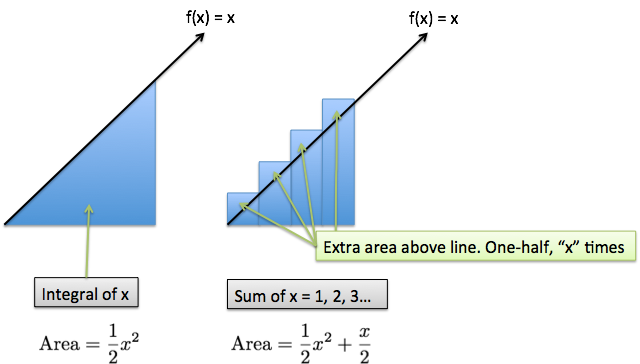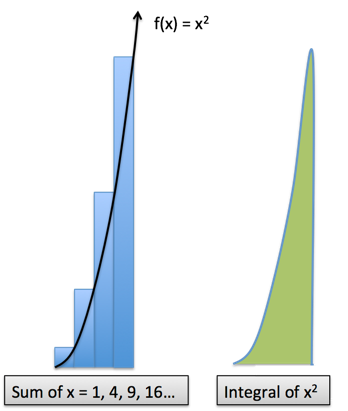Let's say you had to estimate 1 + 2 + 3 + 4 + 5 + 6 + 7 + ... + 100.
What would you do? Well, you could work out the exact formula:

and plug in n=100 to get 5050.
But we just want a rough answer. You have a list of numbers, they follow a simple pattern, and want a quick estimate. What to do?
The "easy" way (well, the Calculus way) is to realize 1 + 2 + 3 + 4 is about the same as f(x) = x. The first element is f(1) = 1, the second is f(2) = 2, and so on.
From here, we can take the integral:

We usually see the integral as a formal, elegant operation, which artfully accumulates one function and returns another. Informally, we're squashing everything together in that bad mamma-jamma and seeing how much there is.
The result frac(1)(2) x2 should be pretty close to what we want.

The exact total is our staircase-like pattern, which accumulates to 5050.
The approximate answer is the area of that triangle, frac(1)(2) base · height = frac(1)(2) 100 · 100 = 5000. The difference is because of the corners in the staircase which overhang. frac(x)(2) is one-half, x times (the size of overhang (1/2) times the number of pieces (x)).
The net result is using a smooth, easy-to-measure shape to approximate a jagged, tedious-to-measure one. (This is a bit of Calculus inception, since we usually use rectangles to approximate smooth shapes.)
More Estimates
This tactic works for other sequences:
What's the sum of the first 10 square numbers? 1 + 4 + 9 + 16 + 25 + ... + 100 = ?
Hrm. The formula is probably tricky to work out. But without our Calculus-infused Arithmetic, a quick guess would be:


Our first hunch should be "one third of 10^3" or 333. But as we saw before, there's an "overhang" that we missed. Let's call it 10%, for an estimate of 330 + 10% ~ 370.
The exact answer is 385. Not bad! The actual formula is:

I'd say frac(x3)(3) isn't bad for a few seconds of work.
Data doubles every year. What does lifetime usage look like?
The integral (squashed-together total) of an exponential is an exponential. In Calculus terms,

The key insight is that all exponential growth is just a variation of ex. If ex accumulates exponentially, so will 2x.
So the total usage to date will also follow an exponential pattern, doubling every year also. Contrast this with a usage pattern of "1 + 2 + 3 + 4 ..." -- we grow linearly (f(x) = x), but total usage accumulates quadratically (frac(1)(2)x2).
My goal is to incorporate math thinking into everyday scenarios. We start with an arithmetic question, convert it to a geometry puzzle (how big is the staircase?), and then use calculus to approximate it.
I know a concept is clicking when I can switch between a few styles of thought. Imagine the problem as a script: how would Spielberg, Tarantino, or Scorsese direct it? Each field takes a different look. (To learn how to think with Calculus, check out the Calculus Guide.)
Happy math.




Leave a Reply
25 Comments on "Quick Insight: Easier Arithmetic With Calculus"
Excellent post! I love these insightful little ideas! You may recall that Guass had a similarly-insightful method of counting the sum to 100: http://mathcentral.uregina.ca/qq/database/qq.02.06/jo1.html
Thanks Mario! I love that Gauss story.
This is pretty nice, Thanks!
Glad you liked it!
Thanks for the post. I’m getting closer to the “Aha”. I think it would be helpful to put … after the 3 in the box that says “sum of x=1, 2, 3” like you did below for the f(x)=x^2. Also I thought of the extra pieces as adding one-half, x times. Does that make sense?
I’ve really enjoyed your posts! Keep it up.
Great feedback! I updated the diagram. I like that phrasing too (one-half, x times), I’ll add it to the post.
Hi Kalid, can you explain why the size of overhang piece is 1/2 in first case ?
Hi Dmitry! If you look at the line f(x) = x, you’ll see it cuts the first 1×1 square exactly down the middle, giving a size of 1/2.
I love the film reference at the end. As both film and math fan, I was thrilled. Awesome work as always!
Can you do statistics next time? I think the subject matter is more intuitive since it can be applied to everyday life. Thanks!
Thanks JJ! I’d like to do more on stats, I have a few articles in a series here: /articles/a-brief-introduction-to-probability-statistics/
I should say I had never got this idea of “Intuition filled Calculus” from anyone.I thank you Kalid for opening up my mind on the same.Hoping for more.
Thanks Arun!
I like your way of learning mathematics and the use of patterns to understand it. I plan to teach mathematics in the middle school in your intuitive approach. Thanks.
Awesome, hope it helps your lessons, I love it when teachers are able to use the material :).
I am a student and what I think is that this site is quite amazing.
These little things when I Study really turn my huh? to Aha!
Thanks for the site.
Glad you enjoyed it, thanks.
Thank you Khalid.
You’re really making maths my favorite subject!
Thanks Jincy!
Great post! I’m struggling to understand how you came up with, “Our first hunch should be “one third of 10^3″ or 333”. Can you expand on that?
It seems like that estimate comes from the integral from the line above that resulted in 1/3 * x^3. Since we wanted the sum of the first 10 squares, x = 10. When we plug in 10 for x, the result is 1/3 * 10^3 = 1000/3 or about 333. Hopefully that helps to clarify!
Thanks Brady, that’s exactly it. The rules of Calculus tell us if we have a pattern of x^2, it will accumulate to (1/3) * x^3. The total accumulation from 0 to 10 would be (1/3) * (10^3) = 1/3 * 1000 = 333.33.
As we see in the diagram, this leaves out the “overhangs” so our estimate isn’t quite correct, which we can adjust for. (I’d like to do more on where Calculus works/doesn’t and how to account for these differences.)
how to compute risks
It looks like the integral cuts through the jaggedness, but the summation operation “fits” the discrete function better. To me, this means I have yet to figure out a standard way to convert a summation notation into a formula notation in the same way an integral notation is transformed.
Yes, Calculus (integrals, derivatives) was intended for “smooth” functions (lines, curves, etc.). There is a version called Discrete Calculus which can deal with jagged staircase patterns that we find in counting. The confusion between the two (“why doesn’t Calculus work perfectly with regular arithmetic?”) was something I had to resolve. Hoping to write more on this.
I lost you at “From here, we can take the integral:” I don’t know what an integral is…